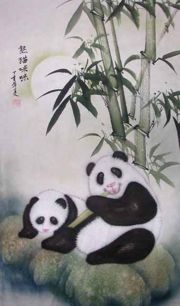Chinese Painting
 From Conservapedia
From Conservapedia 

In China, painting is a long and continuous artistic tradition. With around 5,000 to 6,000 years of work Chinese painters have produced exquisite samples of their art. It covers specially figure paintings, landscapes, trees, rocks, water, dragons, and flower-and-bird paintings. Chinese painters try to capture the essential nature or character of a subject.
Only a few of Ancient Chinese paintings have survived. The earliest drawings that have been preserved till today were produced on paper and silk, which were burial articles with a history of over 2,000 years. [1] The oldest paint brush found in China was dated to 400 B.C. (made with animal hair glued on a piece of bamboo) [2] Some of the oldest existing Chinese paintings are Buddhist works painted in caves and temples.
The earliest paintings were not representational but ornamental; they consisted of patterns or designs rather than pictures. Early pottery was painted with spirals, zigzags, dots, or animals. It was only during the Warring States Period (403-221 B.C.) that artists began to represent the world around them.[3]
Chinese painting can be divided into three major stylistic forms:
- the meticulous, detailed kung-pi style and
- the free, expressive hsieh-I ("sketching ideas") style.
- The middle path avoids both extremes and tries to capture the "inner spirit" of the subjects.[4]
From the 10th century onwards, many painters were also multi-talented poets and calligraphers, who etched poems or descriptive words onto their work. It would be natural that many of the great painters also excelled at calligraphy as it shared many of the brushstroke techniques with Chinese painting. Chinese calligraphy in itself is considered an art that requires years to master.[5]
Buddhism, Confucianism and Taoism had a major influence on Chinese art. Portraits were usually of emperors and noblemen. In 1714, an Italian painter Giuseppe Castiglione introduced the Western painting methods to China. He taught the artists in the imperial court Western styles and methods, and in turn studied Chinese art. This marked the first fusion of Chinese and Western paintings. [6]
During the Yuan Dynasty, Li Kan won the fame as a painter of bamboo; he lived in a bamboo valley for observing the pose of bamboo in morning, in raining or in wind.[7]
Xu Beihong, a famous Chinese painter, wrote: "Chinese art: Its past and future", 1948. His paintings has been sold for millions U.S. dollars. Xu Beihong was one of the first to create monumental oil paintings with epic Chinese themes. In Modern Chinese painting art became a vehicle for political propaganda.
Zao Wou-Ki (1920 – 2013) was a successful Chinese-French abstract painter. Zeng Fanzhi is a contemporary Chinese artist based in Beijing; he achieved recognition in the 1990s for his "Hospital" and "Meat" paintings. Other contemporary outstanding artist are: Zhang Huan, Liu Xiaodong, Yue Minjun, Zhu Jinshi and Xu Zhen.


Chinese painting, arguably Song period.

Chinese painting by Yun Xin.

Chinese painting by Mo Yun.

Chinese painting by Huo Kui.


See also[edit]

- History of painting
- Oriental art

References[edit]
- ↑ http://www.chinaculture.org/gb/en_artqa/2005-12/27/content_77518.htm
- ↑ http://factsanddetails.com/china.php?itemid=257
- ↑ http://www.taohuatancn.com/en/showinfo.aspx?id=115
- ↑ http://factsanddetails.com/china.php?itemid=257
- ↑ http://www.chinaholidays.com/guide/chinese-culture/chinese-painting.html
- ↑ http://www.chinaholidays.com/guide/chinese-culture/chinese-painting.html
- ↑ http://www.china-on-site.com/pages/painter/1010.php
External links[edit]
- Chinese Painting and Calligraphy.
- Chinese Painting.
- History of Chinese Painting.
- The Top 10 Chinese Artists.

Categories: [Painting]
↧ Download as ZWI file | Last modified: 03/01/2023 02:43:51 | 186 views
☰ Source: https://www.conservapedia.com/Chinese_Painting | License: CC BY-SA 3.0
 ZWI signed:
ZWI signed: KSF
KSF